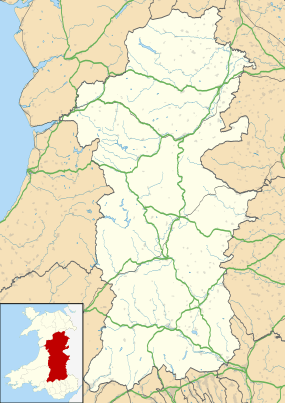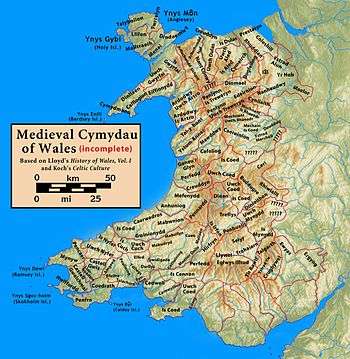Llanerchydol
| Llanerchydol | |
 Llanerchydol Hall |
|
 Llanerchydol |
|
| Community | Llanerchydol |
|---|---|
| Principal area | Powys |
| Ceremonial county | Powys |
| Country | Wales |
| Sovereign state | United Kingdom |
| Police | Dyfed-Powys |
| Fire | Mid and West Wales |
| Ambulance | Welsh |
| EU Parliament | Wales |
Coordinates: 52°39′35″N 3°10′35″W / 52.6597°N 03.1763°W
Llanerchydol is a settlement on the A458 about 2 km west of the centre of Welshpool in the county of Powys in Wales.
Llanerchydol Hall

Llanerchydol Hall, a 14,240 square feet (1,323 m2) Grade II* Listed Building, is located in parkland between the A458 to Llanfair Caereinion and A490 to Llanfyllin.[1] The Hall is a fine and largely intact early 19th-century picturesque Gothic Revival style house, with well preserved park and gardens.[1][2] The site has a long history of occupation, including a Tudor house which burnt down in about 1776, after which David Pugh, a local man who made a fortune selling tea in London, bought the site and built a new house which became known as Llanerchydol Hall.[2][3]
History

Llanerchydol is named after and is near the northern border of Llannerch Hudol (also written Llannerchwdwl, Llannerchudol, Llanerchudol or Llanerchydol), which was a medieval commote (cwmwd) in the cantref of Ystlyg in the Kingdom of Powys.[4][5][6] It was in the south-east of the kingdom (north Powys today), close to the border with England. It was a small commote bordering Y Gorddwr on the east beyond the River Severn, Ystrad Marchell in the north, Caereinion on the west and Cedewain south of the River Rhiw at Berriew.[4]
From the 11th century it was involved in the conflicts between the Norman Marcher Lords and the princes of Powys. When the kingdom of Powys was divided, after the death in 1160 of Madog ap Maredudd, the last prince of the whole of Powys, Llannerch Hudol was given to his illegitimate son Caswallon together with the commote of Broniarth,[7] it subsequently became part of the principality of Powys Wenwynwyn. Its main centre was possibly the Welshpool motte and bailey castle (Domen Castell) built by Cadwgan ap Bleddyn in 1111,[8][9][10] but there are at least three other motte and baileys within the small commote including Powis Castle (Castell Coch) and Ladies Mount.[11][12]
Together with Ystrad Marchell and Deuddwr it formed the Teirswydd ("three commotes") which were among the lands restored into the possession of Gruffydd ap Gwenwynwyn in return for his homage and fealty by Llywelyn ap Gruffudd at Ystumanner in 1263.[13]
Placename
Llannerch Hudol literally means "Magic Glade" or "Wizard's Glade". However, it is common for Welsh placenames to be based on the name of a saint (llan, meaning "church" or "parish", followed by the name or a mutation of it); so it could mean, for example, "Enchanted Parish of St [Unknown]".
References
- 1 2 "Llanerchydol Hall, Welshpool". British Listed Buildings. British Listed Buildings. Retrieved 19 April 2015.
- 1 2 "LLANERCHYDOL HALL". Coflein.
- ↑ "1776 Gothic Revival – Llanerchydol Hall". Old House Dreams. Old House Dreams.
- 1 2 Rees, William (1951). An Historical Atlas of Wales from Early to Modern Times. Faber & Faber.
- ↑ Cathrall, William (1828). The History of North Wales Volume II. J Gleave and Sons. p. 327.
- ↑ "Llannerch Hudol Cmt". Vision of Britain.
- ↑ Yorke, Philip (1887). The Royal Tribes of Wales. London: Isaac Foulkes. p. 58.
- ↑ "Domen Castell, Welshpool". Gatehouse Gazetteer.
- ↑ Smith, J Beverley (2014). Llywelyn ap Gruffudd: Prince of Wales. University of Wales Press. p. 416.
- ↑ "Welshpool Castle". Castle Wales.
- ↑ "Powis Castle". Gatehouse Gazetteer.
- ↑ "Ladies Mount, Powis Castle Park". Gatehouse Gazetteer.
- ↑ Smith, J Beverley (2014). Llywelyn ap Gruffudd: Prince of Wales. University of Wales Press.